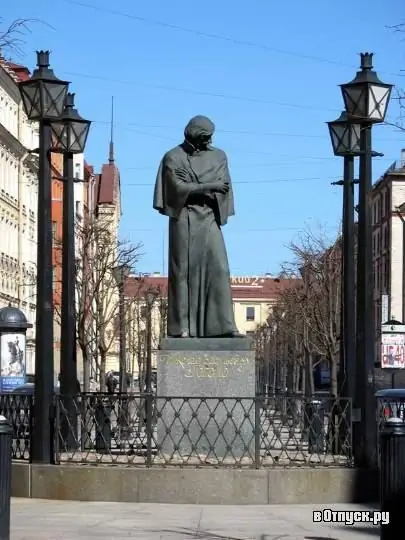
Description of the attraction
In the year of the centenary of the death of the great writer N. V. Gogol, in the 52nd year of the last century, the city authorities came up with a plan to erect a monument to the great writer on Manezhnaya Square in Leningrad. In the same year, a stone was laid at the site of the proposed location of the monument. However, the stone remained in this state until 1999, and the monument to Gogol was erected in another place.
The opening of the monument in a solemn atmosphere happened only in 1997. An old cobbled street in the center of St. Petersburg, one of the first pedestrian streets, Malaya Konyushennaya was chosen as the installation site. Malaya Konyushennaya is the original name. The street in the 18th century changed its name to Rozhdestvenskaya, and then the Soviet authorities renamed it to st. Sophia Perovskaya. Malaya Konyushennaya regained its former name in 1992, on October 4.
In St. Petersburg, the opening of a monument to the writer, author of the immortal "Viy" and "Dead Souls", "Evenings on a Farm Near Dikanka" and "Taras Bulba" and enterprises of the city on the Neva, a list of which can be found on the reverse side of the monument's pedestal. The author of the project of the monument is Mikhail Belov, a former student of M. K. Anikushin, a famous sculptor from St. Petersburg, author of the monument to Pushkin.
The monument on Malaya Konyushennaya is not the only one, but perhaps one of the youngest monuments to Nikolai Vasilyevich. One of the first monuments was erected in Nizhyn by Parmen Petrovich Zabello back in 1881 (now there are two of them). Later, monuments appeared in Moscow on Prechistensky (now Gogolevsky) Boulevard (the real location of the sculpture is Nikitsky Boulevard), Volgograd (Tsaritsyn at the time of the sculpture's erection) on Yekaterininskaya Street (now the street on which the monument stands, by the way, is the oldest in the city, called Gogolevskaya), Dnepropetrovsk, Poltava. In Kiev, there is a monument to the Nose, which can be seen on Andriyivskyy Descent, at 34.
Work on the monument lasted more than one year. Mysticism and mystery in the image of Nikolai Gogol - this is what the sculptor sought to display in his work. The well-known artist-architect Vladimir Sergeevich Vasilkovsky worked on the architectural appearance of the project. The figure of the writer, 3 meters 40 centimeters high, was made in bronze and sits on a granite pedestal. The total height of the monument is five meters. In the workshop of A. V. Rytov, the letters on the pedestal were cut and polished.
The inscription on the facade reads: "Nikolai Vasilyevich Gogol". Indeed, this monument was erected as a recognition and reverence for the inhabitants of the city, to which Gogol devoted so much in his work and in life, because the cycle of Petersburg stories ("Nevsky Prospect", "Portrait", "Overcoat", "Nose", "Notes crazy ") - a special period in the creative activity of Nikolai Gogol, which is often referred to by literary critics as the second," Petersburg "period of the genius writer.
Nikolai Vasilievich stands with his arms crossed, in a long coat with a cape, folds of clothes touching the pedestal. The writer's head is slightly turned to the left, away from Nevsky, his gaze is directed downward. Gogol is thoughtful, and it seems as if walking along a cobbled street, he stopped because he had an inspiration, and he is pondering the idea of a new immortal work. Four lanterns in the old style, installed next to the monument, successfully complement the sculpture and make it possible to harmoniously fit the monument into the architecture of Malaya Konyushennaya.







